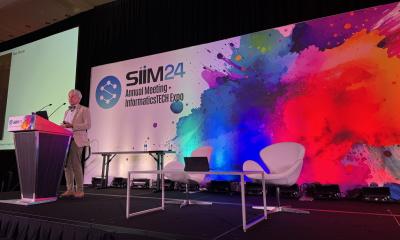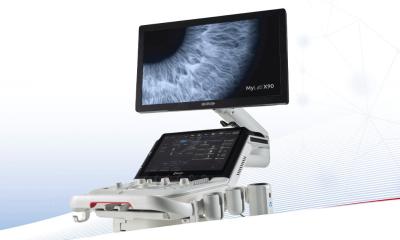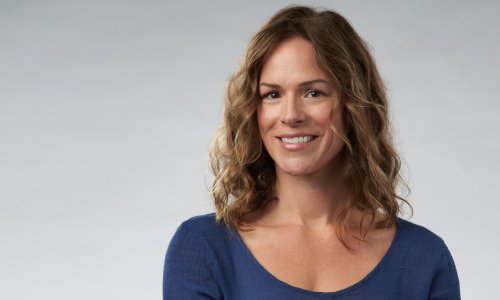Article • Healthcare artificial intelligence
AI – Radiology’s next frontier
Artificial intelligence (AI) technology and its role and future impact on the radiology profession was the dominant theme at RSNA 2017, whether in scientific presentations or in the technical exhibitions. Keith J Dreyer DO PhD addressed this subject head-on in his presentation ‘Healthcare AI – Radiology’s Next Frontier.’
Report: Cynthia E. Keen
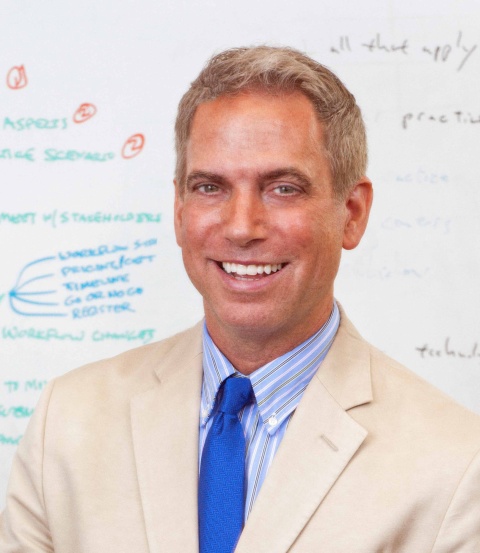
Dr Keith Dreyer, vice chairman of radiology informatics and chief data science officer at Massachusetts General Hospital in Boston, is an acknowledged expert on information technology (IT) innovations in radiology. His prediction, at a packed lecture hall during the joint RSNA/AAPM scientific session, was that an AI future is very bright for radiology and radiologists. Once AI becomes an established technology in radiology, it will allow radiologists more time to work with both clinicians and their patients. Rather than being diminished, radiologists will assume the leadership role of being aggregators of all data that passes through the diagnostic process. Acknowledging the large number of AI-oriented companies exhibiting for the first time and veteran vendors incorporating the subject of AI into their exhibition booths, Dreyer rhetorically asked where the radiology profession is on the pathway to AI expectations? At the very beginning, he answered.
Potentially diagnostic imaging AI will take decades
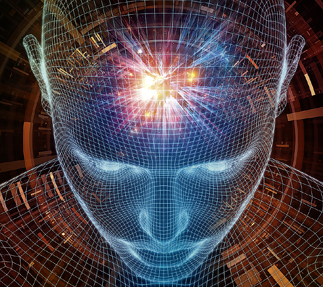
Building an AI algorithm can be surprisingly easy, but converting an algorithm into a sophisticated product that works consistently in clinical use is very complex. He disagrees with deep learning pioneer Professor Geoffrey Hinton, a computer scientist at the University of Toronto, whose remarks at the 2016 Machine Learning and Market for Intelligence Conference that medical schools should stop training radiologists now because they will not be displaced by AI technology in five to 10 years made global headlines.
Digital technology has radically changed the radiology profession: with increasing complex modalities, with electronic health records and the more specialised radiology information systems, with digital imaging and PACS, with cloud storage and global digital image exchange capabilities, and with speech recognition dictation systems and auto-populating structured reporting templates. But these technologies and their adoption have evolved over decades. Diagnostic imaging AI will also potentially take decades because there is a staggeringly large amount of work to do.
The potential for AI has stirred excitement since the 1950’s, but deep learning only began to flourish in 2010. The growth in AI applications over the past five years has been fuelled by rapid advances in technology, growth, data, and massive investment from tech titans, by powerful new applications for known AI techniques, the proliferation of open source software, and sharing of advances. Imaging diagnostics is a hot area for investment, and it behoves organisations like the American College of Radiology (ACR) and the RSNA to get very involved. ‘What you see on the exhibition floor are very narrow applications of AI, focusing on a very specific radiology application. Is this application needed? Just how good does it need to be? What can it solve better than a radiologist?’ Dreyer compared the global diagnostic performance of radiologists to a bell-shaped curve, ranging from random guesses to perfection. What should the standard for an AI algorithm be? He observed that there are many places on the globe where good AI assistance in a very narrow application would be adequate.
Complex work and interaction by multidisciplinary community is needed to have clinical AI take place on a broader scale, and a platform to support all the development of algorithms to deal with thousands of findings and tens of thousands of medical conditions. AI will need to focus on image interpretation, patient care and safety, and radiology practice optimisation for productivity and quality. To show how these AI products reduce costs and improve outcomes will require clinical translation and industrial-grade integration into routine workflow.
Current obstacles include lack of a healthcare AI ecosystem. No standard methods exist to annotate data for AI model training and testing, nor is there a standard mechanism for clinical integration into existing systems and modalities and future ones. AI healthcare standards need to be developed. This is a role that the recently established ACR Data Science Institute (www.acrdsi.org) is tackling. Its objective is to advance data science solutions for radiology care that are clinically relevant, safe and effective. The Institute is working with the USA’s Congress, federal agencies, the healthcare AI industry, professional societies and the healthcare community. Dreyer discussed in detail the numerous issues that need to be addressed with respect to clinically viable AI applications.
Easing the AI premarket approval process
Radiology has an enormous opportunity to leverage AI to become a centre of intelligently aggregated, quantitative, diagnostic information. This is of great interest to the USA’s Food and Drug Administration (FDA), which sees the potential for medical device development tools to ease the process of AI premarket approval and programs such as the National Evaluation System for Health Technology (NEST) to improve post market surveillance through a continuous data feedback loop, as is being implemented by the ACR registry process. Financial reimbursement relating to the use of AI tools in diagnostic imaging must be addressed, a separate but related additional layer of complexity.
Once these hurdles are overcome, Dreyer predicts that the combination of radiologists and AI working in tandem will be far better than either working alone. He told the audience to imagine interpreting an exam in PACS that has already gone to the cloud where quantified findings were made, a patient’s medical record analysed and compared with data, and structured recommendations and guidelines provided. Radiologists will be able to work more intelligently, more accurately, and more efficiently. They will be able to do things that they never could do before. Radiology and AI will further expand the impact of diagnostic imaging. It is a goal our entire profession needs to work toward and embrace.
Profile:
Keith J Dreyer DO PhD is Vice Chairman of Radiology and Director of the Center for Clinical Data Science at Massachusetts General Hospital, USA. He is also Associate Professor of Radiology at the Harvard Medical School. The author of numerous scientific articles and papers is an expert on informatics and focuses his research on various fields including cognitive computing, clinical decision support and digital imaging standards. He has held diverse board and committee positions with healthcare organisations, including the Radiological Society of North America and the American College of Radiology.
Session: Keith J. Dreyer: How will AI change radiology, ECR 2018
27.02.2018



